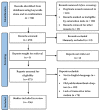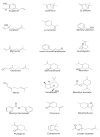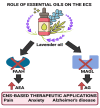Exploring Pharmacological Mechanisms of Essential Oils on the Central Nervous System
- PMID: 35009027
- PMCID: PMC8747111
- DOI: 10.3390/plants11010021
Exploring Pharmacological Mechanisms of Essential Oils on the Central Nervous System
Abstract
Essential oils (EOs) have been traditionally used as ancient remedies to treat many health disorders due to their enormous biological activities. As mainstream allopathic medication currently used for CNS disorders is associated with adverse effects, the search to obtain safer alternatives as compared to the currently marketed therapies is of tremendous significance. Research conducted suggests that concurrent utilization of allopathic medicines and EOs is synergistically beneficial. Due to their inability to show untoward effects, various scientists have tried to elucidate the pharmacological mechanisms by which these oils exert beneficial effects on the CNS. In this regard, our review aims to improve the understanding of EOs' biological activity on the CNS and to highlight the significance of the utilization of EOs in neuronal disorders, thereby improving patient acceptability of EOs as therapeutic agents. Through data compilation from library searches and electronic databases such as PubMed, Google Scholar, etc., recent preclinical and clinical data, routes of administration, and the required or maximal dosage for the observation of beneficial effects are addressed. We have also highlighted the challenges that require attention for further improving patient compliance, research gaps, and the development of EO-based nanomedicine for targeted therapy and pharmacotherapy.
Keywords: Alzheimer’s disease; CNS; aromatherapy; essential oils; nanomedicine.
Conflict of interest statement
The authors declare no conflict of interest.
Figures






Similar articles
-
Natural essential oils derived from herbal medicines: A promising therapy strategy for treating cognitive impairment.Front Aging Neurosci. 2023 Mar 16;15:1104269. doi: 10.3389/fnagi.2023.1104269. eCollection 2023. Front Aging Neurosci. 2023. PMID: 37009463 Free PMC article. Review.
-
Essential oils as anticancer agents: Potential role in malignancies, drug delivery mechanisms, and immune system enhancement.Biomed Pharmacother. 2022 Feb;146:112514. doi: 10.1016/j.biopha.2021.112514. Epub 2021 Dec 25. Biomed Pharmacother. 2022. PMID: 34963087 Review.
-
Pharmacologic effects approach of essential oils and their components on respiratory diseases.J Ethnopharmacol. 2023 Mar 25;304:115962. doi: 10.1016/j.jep.2022.115962. Epub 2022 Dec 15. J Ethnopharmacol. 2023. PMID: 36529244 Review.
-
Essential oils for clinical aromatherapy: A comprehensive review.J Ethnopharmacol. 2024 Aug 10;330:118180. doi: 10.1016/j.jep.2024.118180. Epub 2024 Apr 16. J Ethnopharmacol. 2024. PMID: 38614262 Review.
-
NaturalEssential Oils: A Promising Therapy Way for Treating Ischemic Stroke.J Oleo Sci. 2024 Nov 1;73(11):1377-1396. doi: 10.5650/jos.ess24125. Epub 2024 Oct 17. J Oleo Sci. 2024. PMID: 39414458 Review.
Cited by
-
Revisiting the Therapeutic Effects of Essential Oils on the Oral Microbiome.Pharmacy (Basel). 2023 Feb 10;11(1):33. doi: 10.3390/pharmacy11010033. Pharmacy (Basel). 2023. PMID: 36827671 Free PMC article. Review.
-
Essential Oils and Neuropathic Pain.Plants (Basel). 2022 Jul 7;11(14):1797. doi: 10.3390/plants11141797. Plants (Basel). 2022. PMID: 35890431 Free PMC article. Review.
-
Inhaled Volatile Molecules-Responsive TRP Channels as Non-Olfactory Receptors.Biomol Ther (Seoul). 2024 Mar 1;32(2):192-204. doi: 10.4062/biomolther.2023.118. Epub 2023 Aug 8. Biomol Ther (Seoul). 2024. PMID: 37551139 Free PMC article. Review.
-
Aromatherapy and Essential Oils: Holistic Strategies in Complementary and Alternative Medicine for Integral Wellbeing.Plants (Basel). 2025 Jan 29;14(3):400. doi: 10.3390/plants14030400. Plants (Basel). 2025. PMID: 39942962 Free PMC article. Review.
-
Therapeutic applications of eucalyptus essential oils.Inflammopharmacology. 2025 Jan;33(1):163-182. doi: 10.1007/s10787-024-01588-8. Epub 2024 Nov 5. Inflammopharmacology. 2025. PMID: 39499358 Free PMC article. Review.
References
-
- ChStratakos A., Koidis A. Methods for Extracting Essential Oils. In: Preedy V.R., editor. Essential Oils in Food Preservation, Flavor and Safety. Academic Press; Cambridge, MA, USA: 2016. pp. 31–38.
Publication types
LinkOut - more resources
Full Text Sources
Research Materials

